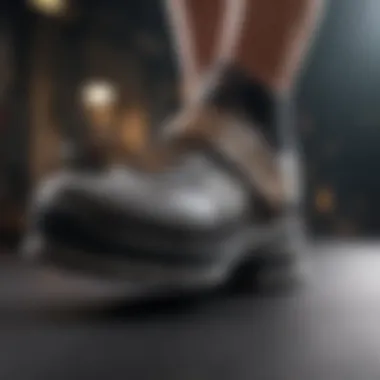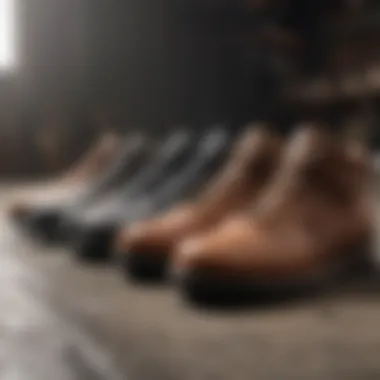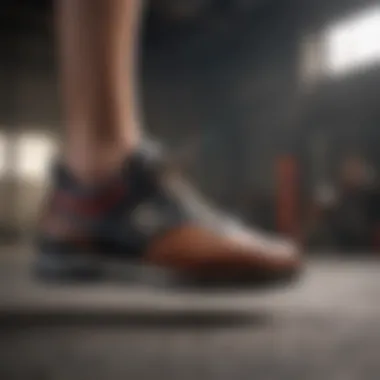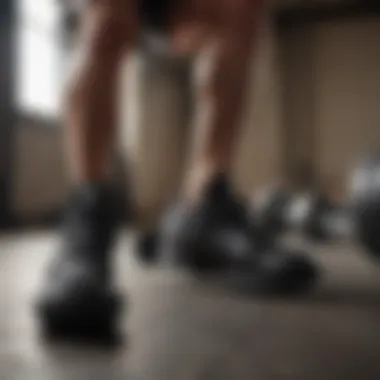The Best Lifting Shoes: A Comprehensive Guide


Intro
Selecting the right lifting shoes is an often overlooked but pivotal element in effective strength training. Proper footwear can greatly influence performance, providing necessary support and stability during weightlifting exercises. This guide aims to break down the various aspects of lifting shoes, from their essential features to recommended brands. By understanding the importance of lifting shoes, both beginners and experienced lifters can optimize their training outcomes.
Understanding the role of footwear goes beyond mere aesthetics. Each component of a lifting shoe contributes to enhancing strength, improving form, and ensuring the safety of the lifter. In this article, we will explore key benefits, practical features, and specific recommendations, tailored for individuals serious about their lifting endeavors.
Key Benefits
Physical Health Benefits
Investing in a quality pair of lifting shoes supports optimal biomechanics. These shoes are designed to provide a stable base, allowing the lifter to maintain correct posture during squats, deadlifts, and overhead lifts. A secured foot placement minimizes the risk of injury and maximizes force transfer from the ground to the barbell.
- Enhanced Stability: When lifting heavy weights, a rigid shoe helps prevent foot movement inside the shoe, ensuring better control of the lift.
- Injury Prevention: Proper footwear can reduce strain on the ankles and knees, mitigating the risk of common lifting injuries.
- Improved Force Transfer: With a flat sole, lifting shoes allow weightlifters to push down more effectively, as opposed to running shoes that absorb impact.
Mental Well-being Enhancements
The mental aspect of lifting should not be neglected. Wearing the right shoes can boost confidence, allowing lifters to focus on their performance rather than on discomfort or insecurity.
- Increased Confidence: Knowing that your feet are secure and properly supported promotes mental reassurance during intense lifts.
- Focus on Technique: Eliminating distractions such as foot pain enables lifters to concentrate fully on their form.
"Quality footwear is a small investment that pays off in the long run by maximizing training results and minimizing setbacks."
Practical Tips
Selecting the right pair of lifting shoes involves more than just looking for a brand name. Here are some practical tips:
- Consider the Sole: Look for a flat and non-compressive sole. Shoes like the Adidas Adipower and Nike Romaleos are known for their robust soles that support heavy-lifting regimes.
- Evaluate the Fit: Ensure a snug fit without being too tight to avoid discomfort during lifts. Trying shoes on with the socks you typically wear while lifting can help in selecting the right size.
- Check for Heel Height: Different lifters may require different heel heights depending on their specific needs. A lifter with ankle mobility issues may benefit from a shoe with a higher heel lift to maintain proper squat form.
Thoroughly researching both features and brands will contribute greatly to making an informed decision. Quality lifting shoes are not just equipment; they can significantly enhance your performance and help foster a positive mental approach to training.
The next steps will cover recommended brands and styles suited for varied lifting preferences.
Prelims to Lifting Shoes
When it comes to strength training, one often overlooks the significance of footwear. Lifting shoes serve as a vital component of an effective training regimen. This section aims to underscore the importance of investing in proper lifting shoes, detailing the specific benefits they offer to weightlifters and fitness enthusiasts.
Definition of Lifting Shoes
Lifting shoes are specialized footwear designed to support weightlifting activities. Unlike regular athletic shoes, lifting shoes have unique features tailored for stability and performance. These shoes generally have a firm sole, a slight heel elevation, and a snug fit. The firm sole provides a solid base, allowing the lifter to effectively transfer force during lifts. The elevated heel helps in achieving a better squat form, enhancing overall lift mechanics. By focusing on such elements, lifting shoes ensure optimal performance during training sessions.
Importance of Proper Footwear in Weightlifting
Proper footwear in weightlifting is not just a matter of comfort; it plays a critical role in lifting technique and safety. Here are several reasons why the right lifting shoes are essential:
- Stability: Lifting shoes provide a stable platform. This stability is crucial for maintaining balance during heavy lifts. It reduces the likelihood of slippage, which can lead to injuries.
- Improved Form: The design of lifting shoes encourages proper lifting form. With a raised heel, lifters can achieve greater depth in squats, which is vital for muscle engagement and overall form.
- Increased Power Transfer: A rigid sole minimizes energy loss, allowing for better power transfer to the ground. This aspect is particularly important for competitive lifters aiming for maximum efficiency in their lifts.
Furthermore, the choice of lifting shoes also carries psychological benefits. Wearing appropriate footwear can enhance confidence in one's ability to lift heavier weights. Investing in quality lifting shoes is, therefore, a foundational step for anyone serious about strength training.


Key Features of Lifting Shoes
Lifting shoes, unlike regular athletic footwear, come with specific features tailored for weight training. These features significantly enhance performance, ensuring that lifters maintain stability, improve their form, and utilize strength more effectively during their workouts. Here, we delve into critical characteristics that distinguish lifting shoes from other types of footwear, focusing on sole material and construction, heel height, and fit and comfort.
Sole Material and Construction
Optimal rigidity
Optimal rigidity is a vital characteristic of lifting shoes. It refers to the stiffness of the sole, which provides essential support during heavy lifts. A rigid sole helps to transfer force effectively from the lifter's foot to the ground. This is crucial in movements like squats and deadlifts, where any loss of energy can hinder performance. The use of materials such as polyurethane or thermoplastic polyurethane ensures a balance between hard structure and comfort. These materials are well-known for their durability and strength, making them a popular choice among serious lifters.
Slip resistance
The slip resistance of lifting shoes is another fundamental aspect. A good lifting shoe should have a non-slip outsole. This characteristic prevents the foot from sliding within the shoe, providing stability during lifts. Often made from rubber or similar compounds, the outsoles are designed to maintain optimal grip on various surfaces. The advantage here is clear: improved traction leads to better control over movements. However, when choosing shoes with high slip resistance, one should consider the trade-off in terms of flexibility, as more rigid outsoles can limit movement in some scenarios.
Heel Height
Standard ranges used
Most lifting shoes come with a heel height ranging from 0.5 to 1.5 inches. This range is designed to provide optimal positioning for various lifts. A moderate heel height allows lifters to achieve better depth in their squats. This enhanced lift position can significantly affect mechanics, allowing lifters with limited ankle mobility to squat more effectively. Choosing the right heel height is crucial as it directly impacts overall lift performance and your range of motion.
Effect on squat depth
The effect of heel height on squat depth can’t be overlooked. A higher heel can facilitate greater knee flexion, thus allowing for a deeper squat. For those aiming to improve squat depth, a lifter can benefit from using shoes with increased heel height. However, a very high heel may not be suitable for everyone, especially for those who prefer lower stance movements or are used to different kinds of footwear.
Fit and Comfort
Size considerations
When it comes to lifting shoes, size considerations are paramount. An improper fit can negatively affect performance and may lead to injury. Each brand often has its own sizing chart, so it is essential to measure one's feet accurately. Many brands recommend considering width as well, especially for lifters with wider feet. A snug fit is preferable; however, there should still be some allowance for comfort during longer training sessions.
Breathability features
The breathability of lifting shoes can play a significant role, particularly in prolonged workouts. Proper ventilation prevents moisture build-up, which can lead to discomfort and irritation over time. Many brands incorporate mesh panels or perforated designs to enhance airflow. While not all lifters prioritize this feature, it can provide added comfort and help maintain foot hygiene, especially during intense training sessions.
"Choosing the right lifting shoes is crucial. They serve as the foundation for your performance and can directly impact your lifting results."
Types of Lifting Shoes
The selection of lifting shoes is critical for optimizing performance in strength training. Different designs cater to various lifting styles, primarily Olympic lifting, powerlifting, and cross-training. Each type offers unique benefits and considerations crucial for athletes. Choosing the right shoe can significantly impact stability, force transfer, and overall lifting effectiveness.
Olympic Lifting Shoes
Unique characteristics
Olympic lifting shoes are designed for those who practice the Olympic lifts, such as the clean and jerk or the snatch. The defining feature of these shoes is the raised heel, typically ranging from 0.75 to 1.25 inches. This elevation aids in achieving deeper squat positions while maintaining an upright torso, aligning the body effectively with the barbell. The rigid sole provides stability during lifts, ensuring minimal energy loss.
Optimal use cases
These shoes are optimal for Olympic weightlifters and athletes performing explosive movements. The raised heel reduces ankle mobility demands, enabling lifters to achieve optimal positions more easily. However, they may not be suitable for other weightlifting styles. If a lifter also engages in powerlifting, they might find these shoes lacking in necessary support for heavier squats or deadlifts.


Powerlifting Shoes
Design differences
Powerlifting shoes differ significantly from their Olympic counterparts. They typically feature a flatter sole, often constructed from harder materials. This design allows for better force transfer during lifts, particularly in the squat and deadlift. A major characteristic is the supportive structure, often including straps for added security, giving the lifter confidence when handling heavier weights.
Performance advantages
The primary advantage of powerlifting shoes is their stability during static lifts. The flat sole and firm construction allow lifters to push force directly through their feet with minimal compression. This efficiency is indispensable when striving for personal records. Nevertheless, users should be aware that comfort might not be as pronounced as in shoes designed for Olympic lifting or general fitness.
Cross-Training Shoes
Versatility vs. specialization
Cross-training shoes are made for various activities, making them versatile. They accommodate weightlifting, running, and general gym workouts. This flexibility attracts a broad audience. However, their lack of specialization might limit effectiveness in heavy lifting compared to Olympic or powerlifting shoes. The cushioning generally provides comfort for longer workouts but doesn't always translate to optimal weightlifting performance.
Appropriate training contexts
These shoes suit individuals who participate in mixed training regimens. They perform well in circuit training or high-intensity workouts that combine lifting, cardio, and mobility work. On the downside, serious lifters might find they sacrifice strength training stability for versatility. Those focusing solely on lifting may benefit more from shoes tailor-made for that purpose.
Top Brands for Lifting Shoes
When discussing the importance of lifting shoes, the brands that produce these shoes play a critical role in performance and choice. The right brand can greatly influence the overall experience of lifting. Each brand brings unique features, technologies, and designs that cater to different lifting styles and preferences. Assessing these brands helps one to make informed decisions that meet specific training needs.
Nike
Signature models
Nike offers a range of signature models, making them a prominent choice among lifters. Whether you are an Olympic weightlifter or a powerlifter, there is likely a Nike shoe model tailored to your needs. One key characteristic of these models is their responsive cushioning. This is beneficial, as it helps absorb impact during lifts, allowing for better recovery between sets. One notable feature is the innovative Flyknit upper, which enhances breathability while maintaining a snug fit.
Performance features
Nike shoes are known for their performance features that enhance lifting efficiency. The flexibility in the toe area supports natural foot movement during lifts. This design allows for improved stability and balance. Additionally, many models include a durable rubber outsole for excellent grip on various surfaces. This characteristic is influential for lifters who appreciate a reliable footing during their training sessions.
Adidas
Notable offerings
Adidas has established itself as a key player in the lifting shoe market. Their notable offerings include the Adipower and the Powerlift models. The key characteristic of these shoes is their elevated heel, which aids in achieving greater squat depth. This helps lifters maximize their potential in lifts targeting the lower body muscles. A unique feature of some Adidas models is the use of a lightweight yet strong material, which offers durability without sacrificing weight.
User feedback
User feedback is a crucial aspect of understanding the effectiveness of Adidas lifting shoes. Reviews often highlight comfort and fit as significant reasons users choose these shoes. Many consumers appreciate the stability these shoes provide during heavy lifts. However, it is also noted that some models may not fit wider feet comfortably, which can be a downside for certain lifters. Feedback from users gives insight into long-term performance and satisfaction with the shoes.
Romaleos
Competitive edge


Romaleos, produced by Nike, is recognized for its competitive edge in weightlifting. The design focuses on power transfer efficiency during lifts. One vital characteristic is its rigid sole, which promotes stability when lifting heavy weights, giving confidence to the user. Unique to Romaleos is the adjustable straps around the ankle, which allows for a customized fit. This is advantageous for individuals who need extra support in that area.
Pricing analysis
Pricing analysis of Romaleos reveals that they are more expensive compared to other brands. This could be seen as a disadvantage for budget-conscious lifters. However, many consider this investment worthwhile due to the quality and durability of the shoes. The higher price point is often justified by the enhanced performance and the longevity of the product, making it appealing to serious athletes.
Reebok
Product variety
Reebok stands out for its wide product variety in lifting shoes. They offer options suitable for both casual lifters and serious competitors. A notable characteristic of Reebok shoes is their diverse styles and colorways, appealing to a broad audience. This variety allows users to find a model that fits not only their performance needs but also their aesthetic preferences. Unique features like lightweight construction and ample toe space are advantages for those seeking comfort during extensive training sessions.
Consumer preferences
Consumer preferences regarding Reebok lifting shoes often revolve around versatility and adaptability. Many users appreciate the ability to transition from lifting to other forms of training without changing shoes. This makes Reebok a popular choice for cross-trainers or those engaged in varied workouts. However, some reviews indicate that specific models may not offer the same level of rigidity needed for competitive lifting, which can be a consideration for serious athletes.
Choosing the Right Lifting Shoe
Choosing the right lifting shoe is crucial for anyone engaged in strength training. Unlike regular footwear, lifting shoes are designed specifically for stability and support during weightlifting. Their unique attributes can greatly enhance performance by improving form and maximizing power output. Understanding the various elements involved in selecting suitable lifting shoes is essential to achieving optimal results.
Assessing Training Goals
When considering lifting shoes, one must first assess training goals. Are you focused on powerlifting, Olympic lifting, or general weight training? Different shoes cater to distinct objectives. For instance, powerlifters may benefit from shoes designed to provide minimal heel height for a more stable base during deadlifts. Olympic lifters, conversely, typically prefer shoes with elevated heels to facilitate better squat mechanics. Thus, aligning shoe choice with specific training goals is the first step toward enhancing performance.
Analyzing Foot Structure
Arch Type Considerations
Arch type is a significant factor in choosing lifting shoes. People generally have high, medium, or flat arches. A high arch often requires additional support, while flat feet benefit from stability features found in certain models. Selecting a shoe that matches your arch type can prevent injuries and improve biomechanical efficiency during lifts. Well-supported arches facilitate better force transfer, thus maximizing workout effectiveness.
Width and Fit
Width and fit are essential elements in selecting optimal lifting shoes. Shoes that fit comfortably will help prevent blisters and soreness during intense training sessions. It's essential to consider both the width of the shoe and the overall fit. A snug fit without being overly tight allows for better foot control, which is critical during heavy lifts. Shoes that are too wide can cause instability while lifting, potentially hindering performance.
Testing and Trialing Shoes
In-Store Fit Checks
In-store fit checks are an important practice for selecting lifting shoes. Trying shoes in person allows one to evaluate comfort and fit directly. One can assess how the shoes feel during basic movements, ensuring that they offer the necessary support while providing comfort. A proper fit can make all the difference, so it’s advised to test different sizes and models. Some specialized stores may also have knowledgeable staff to guide the selection process.
Return Policies
Examining return policies is vital after purchasing lifting shoes. Many brands offer flexible return periods, allowing customers to try their shoes in real training conditions. This feature is useful for ensuring that the shoe performs as expected during workouts. If the shoes are uncomfortable upon further testing, having a robust return policy can save time and prevent wasted money. Always keep this in mind when making a purchase.
The End
The significance of lifting shoes in the context of strength training cannot be overstated. They contribute substantially to an individual's performance by ensuring stability and proper form during various weightlifting exercises. By selecting the right footwear, lifters can optimize their efforts, leading to better results in strength gains. Each type of lifting shoe offers unique benefits tailored to specific lifting styles, such as Olympic lifting or powerlifting. These shoes also come in various structures, giving preference to factors like heel height and sole material. As discussed in previous sections, understanding these characteristics can considerably affect lifting efficiency.
Final Thoughts on Lifting Shoes
In summary, lifting shoes play a critical role in enhancing the overall weightlifting experience. Their specialized design aids in maintaining proper posture, distributing weight evenly, and preventing injury during dynamic movements. For both beginners and seasoned athletes, investing in quality lifting shoes can serve as a foundational step to promote effective training routines. As lifters advance in their journey, the need for shoes that cater specifically to their evolving techniques and methods becomes paramount.
Importance of Continuous Assessment
The process of finding the ideal lifting shoes does not conclude with a single purchase. Continuous assessment of training needs and shoe performance is essential. Factors like foot structure, changes in training intensity, and varying workout preferences can necessitate a different selection. Regularly evaluating lifting shoes can ensure that they consistently provide the support and stability required. Monitoring the wear and tear of shoes over time is also crucial; worn-out shoes may compromise performance and increase the risk of injury. Revisiting this topic periodically fosters informed choices and can lead to substantial improvements in training outcomes.















